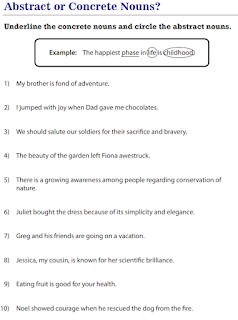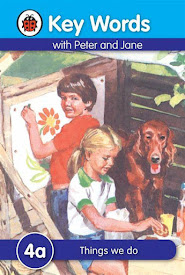Nouns worksheets and explanation for grade 1 to 5
"Nouns worksheets and explanation"
The simplest definition of a noun is a thing and nouns are the basic building blocks of sentences. These things can represent a person, animal, place, idea, emotion – almost any thing that you can think of. Dog, Sam, love, phone, Chicago, courage and spaceship are all nouns. The more nouns you know in a language, the better you will be able to communicate your ideas. Here, we’ll take a closer look at what makes a noun a noun, and we’ll provide some examples of how nouns are used.
Noun examples: respect, faith, apple, seashore, peanut, motorcycle
Noun examples in the following sentences are in bold for easy identification.
- The boy and girl were holding hands as they crossed the bridge on the way to town.
- John loves watching the cat playing with the pink yarn.
- Visiting Big Ben was a highlight of the trip to England,
Forms of Nouns:
The same noun can appear in different forms, depending on how it is used.
A countable noun can be singular or plural. Most nouns in English form the plural by adding -s or -es to the noun, although there are some exceptions:
- One dog, two dogs, red dog, blue dog.
- I missed not just one bus today, but two buses.
- New York City is one of the grandest cities in the world.
Uncountable nouns and proper nouns are always considered to be singular:
- The air in the countryside and in the city is clean and fresh (not the airs).
- All knowledge is a good thing (not knowledges).
- Florida has mostly warm weather in the winter.
Nouns can also indicate ownership. This form of a noun is called a possessive noun, and is indicated by an apostrophe and the letter –s. It is equivalent to using the word of and the noun.
- The light’s color is red. (or: The color of the light is red.)
- The country’s flag has blue stripes. (or: The flag of the country has blue stripes.)
- The hunters’ guns were loaded. (or: The guns of the hunters were loaded.)
Note that when the noun already ends with -s, possession is indicated by adding only an apostrophe – hunters’ guns, not hunters’s guns.
A noun can be used as the subject of a sentence, or in another capacity as an object:
- John is nice. – John is the subject of the sentence
- I saw John – John is the simple (direct) object of the sentence.
- I gave John the phone. – John is the indirect object of the sentence.
- I gave the phone to John. – John is the object of the preposition to.
There are several categories of nouns, and there can be an overlap across the categories. For example, there are common and proper nouns, and concrete and abstract nouns, yet some nouns are both concrete and common, or concrete and proper. It will become clear as you read on.
Common nouns are the words that refer to most general things: country, evening, laughter, puppy, umbrella
Common noun examples in the following sentences are in bold for easy identification.
- Cathy loves the weekends in the country.
- We enjoy swimming after breakfast.
- The cup fell and broke.
Proper nouns are the name that identifies someone or something, a person or a place. Proper nouns are capitalized. John is a proper noun, since the word John represents a particular, single example of a thing, John.
Proper noun examples: Mary, Jimmy, Aunt Audrey, Honda, Philadelphia
Proper noun examples in the following sentences are in bold for easy identification.
- Emily loved spending time with her Aunt Nancy in Paris.
- Buick and Jeep are two important carmakers.
- We visited Lake Erie, which separates the United States and Canada.
Concrete nouns represent a thing that is real and tangible: pig, person, rock, smell, air, soup, Larry are all concrete nouns.
Concrete noun examples: cup, computer, diamond, rollercoaster, shampoo, Debby
Concrete noun examples in the following sentences are in bold for easy identification.
- The person threw the rock across the yard.
- My dog, Oreo, jumped in the air and caught the ball!
- Can you smell the soup, John?
An abstract noun represents a thing that is more like a concept or idea: love, integrity, democracy, friendship, beauty, knowledge are examples of abstract nouns.
Abstract noun examples in the following sentences are in bold for easy identification.
- Love and friendship are equally important.
- Beauty is in the eye of the beholder.
- Your mind can know a million things.
Nouns can also be categorized as countable or uncountable.
A countable noun is a thing can be numbered or counted: airplane, sock, bowl, noodle, teacher, as in two airplanes, three socks, 1000 noodles.
Countable noun examples: peach, horse, shirt, telescope
Countable noun examples in the following sentences are in bold for easy identification.
- There are five dogs in the street.
- I bought three tons of coal.
- Margaret has six pairs of blue sandals.
Uncountable nouns can have a quantity or amount but cannot be actually counted: water, music, clothes, understanding. In the second example above, tons is a countable noun, but coal is not. Coal is referred to as an uncountable noun.
Uncountable noun examples: hate, confidence, attractiveness, wisdom
Uncountable noun examples in the following sentences are in bold for easy identification.
- Love is in the air.
- The four elements are air, earth, fire and water.
- Her humor knows no bounds.
Collective nouns refer to a group of people or things: audience, team, bunch, family, class. When speaking of collective nouns, Americans consider them as singular, using singular verbs with them, such as the group dances happily. When speaking British English, both singular verbs and plural verbs might be used, as in the group dance crazily before the Queen.
Collective noun examples: government, jury, team, bunch, school, class, and room (the people in the room or building)
Collective noun examples in the following sentences are in bold for easy identification.
- The team threw confetti when it was over.
- Steve buys the band some sandwiches.
- Meredith told the class she was getting married.
As mentioned above, when we talk of categories of nouns, some nouns can be described as being in more than one category. Some nouns are concrete and countable, for example, such as raindrops and wedding rings, while some are proper and uncountable, such as the Atlantic Ocean and Alaska.
PRACTICE WORKSHEETS ARE ATTACHED BELOW ALONG WITH Msword FILE attached :

























Comments
Post a Comment